If you’re ready to try road tripping in a recreational vehicle, you aren’t alone. RV travel is in the midst of a massive revival. Road warriors old and new are seeking out everything from camper vans to shining silver Airstreams, large Class A RVs to teeny teardrop trailers, and are heeding the call of the open road.
Whether you’re considering a fall foliage road trip, thinking of jumping in an RV for the holidays, or plotting a spring or summer 2021 RV adventure, the great thing about RVs is that this style of road tripping is much more weatherproof than its close cousin, camping (especially if you opt for an RV with air conditioning or heating, which are standard features in newer models).
For first-timers or those who haven’t been in an RV since the 1980s, we’ve put together a primer on what renting an RV is like in the current century. So much about RV travel that was always great hasn’t changed (driving through beautiful landscapes, bringing your overnight accommodation with you), while many things have improved, including the types of vehicles now available to you. Here’s your complete guide to renting an RV trip for an epic road trip adventure.
Types of RVs
Figuring out what kind of RV is right for you might be one of the most overwhelming parts of the initial RV road trip process. There are two main categories of RVs—RVs and RV trailers. RVs are all-in-one recreational vehicles (meaning you’re driving the vehicle that also serves as your accommodation) and can range from more compact camper vans to behemoth motorhomes, while trailers are an attachment that you tow with your car. Here is a cheat sheet.
Class A RV
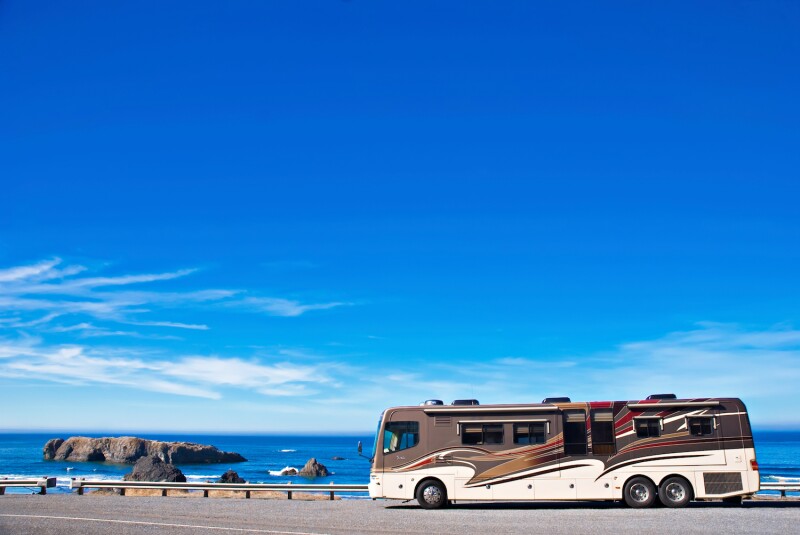
A Class A RV is the epitome of go big or go home.
Photo by Shutterstock
When you see something rolling down the road that looks like it could be a rock band’s tour bus, it’s likely a Class A RV. These larger vehicles typically range from around 20 to 45 feet in length; some models can sleep up to 10 people, and they can be major gas guzzlers. Driving them can take some getting used to, but if you want a lot of comfort and amenities and are planning an extended road trip and longer-term stays, a Class A might be worth a try.
Class B RV (aka a camper van)

A campervan is the RV of choice for many.
Courtesy of Outdoorsy
These tricked-out vans have exploded in popularity of late (try hitting the road without spotting a souped-up Mercedez Sprinter van these days) and it’s not hard to see why. Their more compact size makes them much easier to drive, to start. They definitely don’t have all the amenities of a larger Class A or even a Class C RV, but they’re typically outfitted with a small kitchen, a bed, and storage. Some (but not all) have toilets, too. Their smaller square footage makes them ideal for one or two adults, though some can squeeze in a few more people depending on the layout.
Class C RV
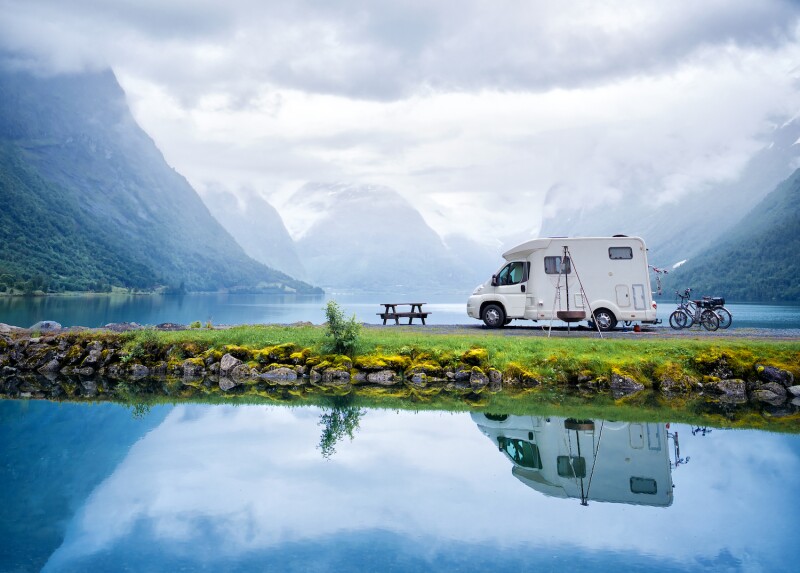
If you’re looking for something not too big and not too small, aim for a Class C RV.
Photo by Shutterstock
These medium-sized RVs are built onto a regular truck body, which makes them a great starter RV. They’re easier to drive than the monster Class As, but have more features than the more compact Class B.
“The most popular type of RV for first-timers is a drivable Class C,” Jon Gray, CEO of RV rental company RVShare, told AFAR. “They are fairly priced and can sleep up to six. With a little bit of practice, they are easy to drive and have all the amenities with beds, a bathroom, and a kitchen all onboard.”
RV trailers
RV trailers are RVs that you tow with a car. When looking into trailers, make sure you know what kind of tow vehicle you will need. Depending on the size of the trailer, you may need a more powerful tow vehicle, for instance a larger truck or SUV.
Travel trailer
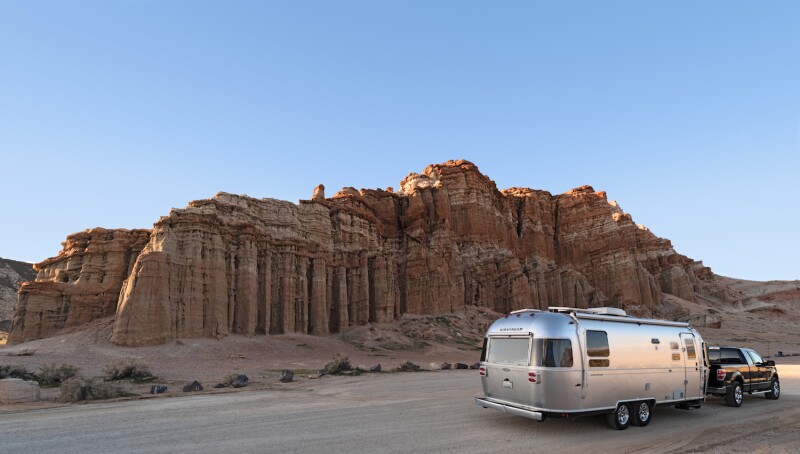
If you want the freedom to roam more easily in-destination, a detachable travel trailer is a great option.
Photo by Shutterstock
This is the most all-encompassing category of trailers. Travel trailers can range considerably in length and in layout.
Pop-up trailer
Also known as tent trailers, these are often smaller or flatter trailers with canvas sides that either literally pop up or need to be physically assembled. While they’re lighter and more compact on the go, they require a bit more work on arrival, and typically do not have heat or A/C.
Fifth wheel trailer

Fifth wheel trailers are full of amenities, but require the right tow vehicle and equipment.
Courtesy of Outdoorsy
The largest of the RV trailers, fifth wheel trailers usually require a specific type of tow hitch that goes into the bed of a truck (not really beginner stuff). These can rival Class A RVs both in size and in amenities.
Teardrop trailer
Technically, these are just tiny travel trailers, but their small size and charm make these attractive shell-shaped beds on wheels an alluring option.
How to rent an RV
Renting an RV is a great way to try out different models to see which work best for your style of travel. The options for renting an RV are more plentiful than you might realize. RV and RV trailer rentals can range anywhere from around $50 per day to upwards of $800 per day depending on the size, make, and model. Most fall in the $100 to $250 per day range.
You can also get your RV delivered either to your home or to your destination. RV rental companies RVshare and Outdoorsy include an option to have owners deliver the RV to your campsite and get everything set up for your arrival so you don’t even have to deal with driving the vehicle if you don’t feel comfortable doing so.
For those looking to do long cross-country drives or who are relocating, you can book one-way RV rentals as well (more on that below).
If you can, do a walk-through of your vehicle (which you can arrange with the owner or the company you are renting from) before setting out and make sure you know how to set up and dump water and sewage hoses and tanks, adjust the heating and cooling, and find the electrical hookups. Even things that may seem simple like extending and collapsing the awning can be tricky and differ from one vehicle to next. Many rental companies offer virtual walk-throughs as well.
Companies that offer RV rentals
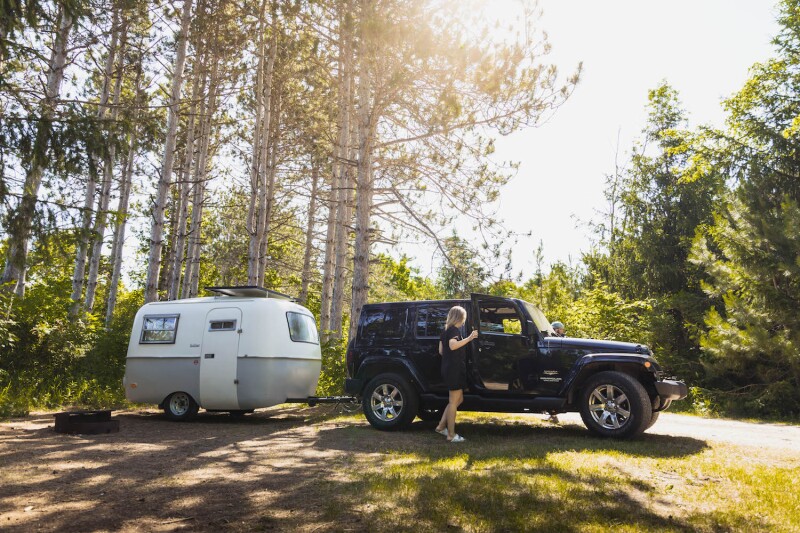
A great place to start is Outdoorsy—the Airbnb of RV rentals.
Courtesy of Outdoorsy
Outdoorsy
Billed as the Airbnb of RVs, Outdoorsy enables RV owners to rent out their vehicles to would-be road-trippers. The listings include Airstreams, camper vans, teardrop trailers, Class C RVs with all the bells and whistles, and more. Outdoorsy is available in 14 countries and lists more than 50,000 RVs and trailers.
RVshare
What better way to try an RV than to rent one from someone in your area? That’s exactly what RV rental site RVshare allows you to do. The site features more than 100,000 vehicles ranging from Class A motorhomes to small travel trailers.
VacationRenter
If you want to do a more comprehensive search for RVs, head to VacationRenter, which lists vehicles from both RVShare’s and Outdoorsy’s inventories. This is a great one-stop-shop for finding local RVs to rent.
Cruise America
Cruise America is a classic. This RV rental company dates back to 1972 and specializes in renting out four different models of Class C RVs, ranging from a truck camper that sleeps up to three people to a cabover motorhome that sleeps up to seven. All have toilets, a gas stove, air conditioning, and are pet friendly. Cruise America has 128 locations in 33 U.S. states and in five Canadian provinces.
Peace Vans Rentals
Seattle, Washington–based Peace Vans Rentals specializes in Volkswagen camper vans outfitted with new or rebuilt motors. Its fleet includes cult favorites such as Vanagons (Westfalias and Weekenders), Eurovans, and Mercedes-Benz Metris campers.
Road Trip Oregon
Road Trip Oregon, based in Portland, specializes in renting out Volkswagen Eurovan campers, built-out Land Rovers, Mercedes Sprinters, and Ford Transits.
Native Campervans
You can rent Ram ProMasters (in two sizes) or a Dodge Grand Caravan camper van in Denver, Salt Lake City, or Las Vegas from Native Campervans. Most are equipped with a sink, a fridge or cooler, a gas stove, cooking utensils, and a foldaway table.
Wayward Campers
New York City road trippers can rent rebuilt Ford E-350 camper vans that have a bed, gas stove, and refrigerator from Wayward Campers.
Planning where to go in your RV
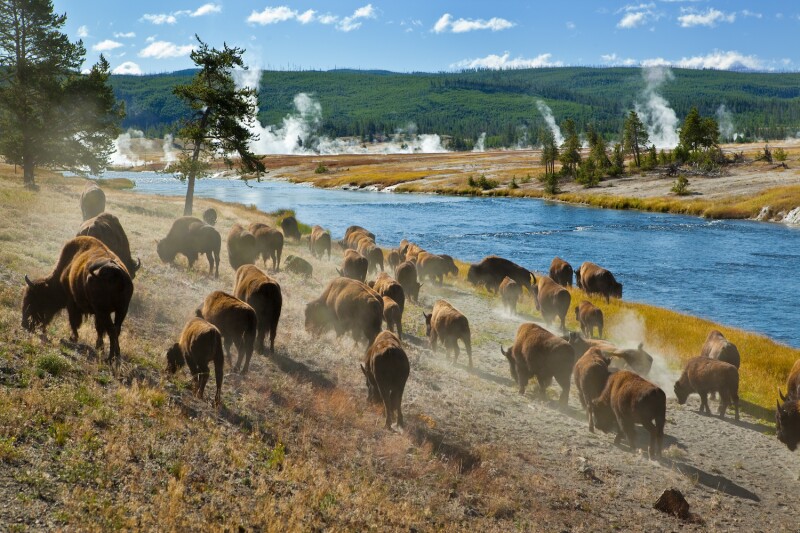
Yellowstone National Park in Wyoming is a popular destination for road tripping RVers.
Photo by Shutterstock
Once you’ve chosen your ideal RV, it’s time to figure out where to actually go with your hotel on wheels. How much do you want to be driving, and how long do you want to stay in each destination?
“The most important thing is to consider the trip you are planning and what’s important to you,” says Marco del Rosario, COO of VacationRenter.“If you’re taking a scenic road trip through national parks, you may consider smaller options that handle better like a Class B, C, or even camper van. If you’re looking for more space, and will be keeping the vehicle parked and acting more as a homebase for the family, consider a Class A.”
There are ample road trip itineraries to consider that are great for RVs, including this list of epic trips to take in your camper van or trailer. Here are some of our favorite road trips across the country:
- The 14 Best Road Trips in the U.S.
- 7 Classic California Road Trips
- 11 New England Road Trip Itineraries
- The Ultimate Colorado Road Trip
- 10 Best Road Trips From Chicago
- The Ultimate New Mexico Road Trip
- The Ultimate Texas Hill Country Road Trip
- The Ultimate Blue Ridge Parkway Road Trip
- The Little-Known Idaho Road Trip You Need to Drive
As for the old standards, “many [road-trippers] travel west to explore our country’s greatest national parks like Yellowstone National Park, Glacier National Park and the Grand Canyon,” says RVshare’s Gray. But “this year, we have seen a lot of travelers rent and stay closer to home to explore state parks and nearby campgrounds.”
If you’re going somewhere more remote, download maps or instructions ahead of time as you may not have cell service to assist with navigation. (Some RV parks offer wireless internet connection, and the other options for internet connection are your phone, purchasing a wireless hot spot, or getting a cellular booster to aid with connectivity.) Similarly, the more remote, the fewer the dining and shopping options are likely to be. Stock up on groceries and provisions ahead of time—one of the great advantages of RVs is that many are equipped with refrigerators that will keep your food cold on the road as well as ample storage.
Where to park your RV

If you’re looking to get off the grid, head to Hipcamp for unique camping sites like this Shitake mushroom farm in New York.
Courtesy of Hipcamp
No matter where you’re going, consider that many campgrounds and RV parks require advance reservations. If you’re planning to travel to popular destinations like U.S. national parks, they may be booked up well in advance (even several months out—each park has a different reservation system). Remember that parking an RV is not like pitching a tent. If you want to have access to water, power, and sewage, you will need to reserve a campsite outfitted specifically for RVs. Make sure to find out whether the campsite allows fires as well. (Since many RVs have stoves, this may not be an issue.)
In addition to the plethora of RV-friendly campsites located within national and state parks (you can reserve these through each park’s website), Kampgrounds of America (KOA) is a great option. The KOA network is massive—there are more than 500 KOA campgrounds throughout the United States and Canada.
Related How to Book Truly Unique Camping Experiences
If you’re looking for something a little less conventional, the booking platform Hipcamp lists unique public and private camping sites across the United States. Options include parking your RV on vineyards, farms, ranches, and on truly picturesque plots of land (with mountain views, on lakeshores, and along the beach). Hipcamp also has a handy mobile app for when you want to book one of the 300,000 convention-breaking campsites.
For those who aren’t sure which campground they want to settle into, The Dyrt is a camping, RV park, and lodging review site and mobile app that offers user-based photos and reviews of more than 300,000 listings.
How to rent an RV for a one-way trip
For travelers who are interested in doing a one-way RV trip, many RV rental companies offer this as an option. With numerous locations in the U.S. and Canada, Cruise America provides thousands of one-way rentals to customers each year. There is typically an additional fee for one-way rentals, which Cruise America issues on a case-by-case basis.
One-way rentals are also available through sites like RVshare, which has an entire microsite dedicated to helping renters find the right one-way route and vehicle. Prices vary depending on the size of the RV and the route.
Tips for getting RV insurance
You will want to make sure you’re covered while on the road in your rented RV. If you have existing car insurance coverage, call to see if you’ll be covered for the rental. Also find out whether you have roadside assistance through your insurer or with a membership organization such as AAA.
If you’re not covered, you’ll want to consider getting coverage through the company renting you the vehicle or through a third-party insurer such as Good Sam, RVinsurance.com, National General, and Progressive.
You can also opt for travel insurance that would cover you for other possible expenses or losses, which could be especially helpful on longer road trips.
“Travel insurance is great for road trips as it provides additional protection for your luggage and even your sporting equipment,” says James Sion, COO of travel insurance provider Generali Global Assistance. “Depending on the level of coverage you purchase, travel insurance can cover you for emergency medical costs for a sickness or injury that you incur during your trip, travel delays due to adverse weather, and lost or stolen luggage.”
>> Next: Inside the Growing Community of Families on the Road, Full Time











